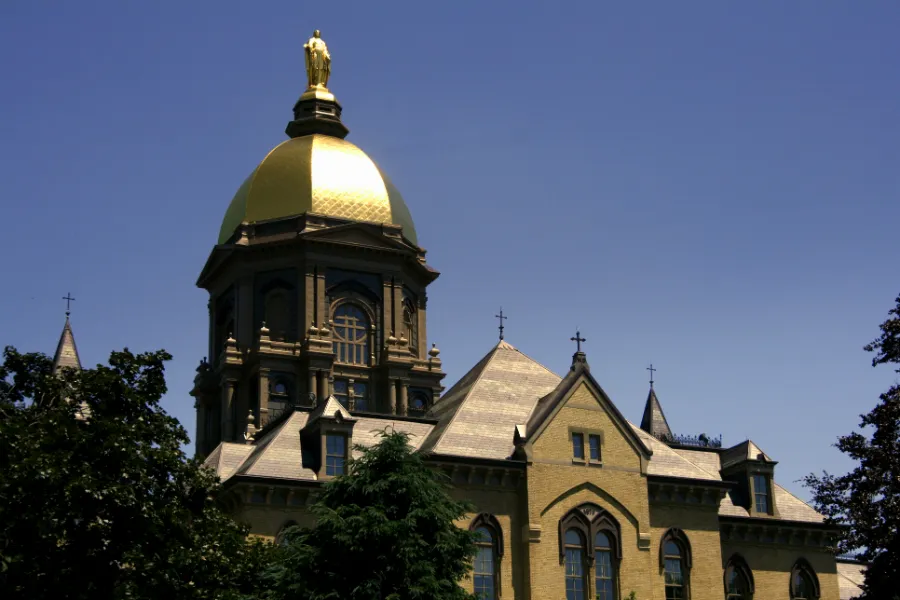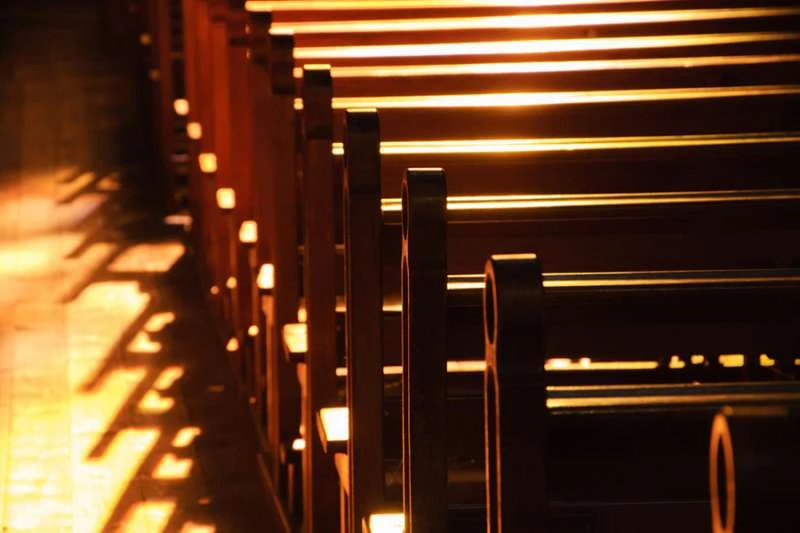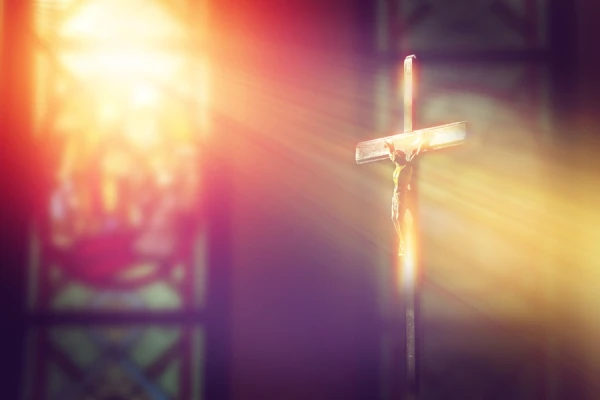
South Bend, Ind., Jan 21, 2019 / 06:01 pm (CNA).- A series of murals depicting Christopher Columbus' life and exploration displayed at the University of Notre Dame will be covered up, the university's president announced Sunday.
“Painted in 1882-84 … they reflect the attitudes of the time and were intended as a didactic presentation, responding to cultural challenges for the school’s largely immigrant, Catholic population,” Fr. John Jenkins, C.S.C., wrote in his Jan. 20 letter announcing the decision.
“In recent years, however, many have come to see the murals as at best blind to the consequences of Columbus’s voyage for the indigenous peoples who inhabited this 'new' world and at worst demeaning toward them.”
The murals, painted by Luigi Gregori, are located in Notre Dame's Main Building. Gregori served for a time as artist in residence at the Vatican, before becoming a professor and artist in residence at the Indiana university.
Gregori was commissioned to produce a series of murals of Columbus by Fr. Edward Sorin, the founder and first president of the University of Notre Dame. One of the murals was the model for the first series of commemorative stamps issued by the U.S., in 1893.
Jenkins said that he has heard in recent years “from students, alumni, faculty, staff, representatives of the Native American community, and others on this complex topic,” and that his decision was made after consulting with the Board of Fellows.
Though a brochure to explain the murals' context has been provided since the 1990s, “because the second-floor hall of the Main Building is a busy throughway for visitors and members of the University community, it is not well suited for a thoughtful consideration of these paintings and the context of their composition,” Jenkins wrote.
The brochure was created after a group of Native American students called for the murals' removal in 1995.
The priest said that there will be “a permanent display for high-quality, high-resolution images of the murals in a campus setting to be determined that will be conducive to such an informed and careful consideration.”
The murals themselves will “be covered by woven material consistent with the décor of the space, though it will be possible to display the murals on occasion.”
The university president announced that a committee will be formed “to decide on the place to display the images of the murals and the appropriate communication around the display.”
“The murals present us with several narratives not easily reconciled, and the tensions among them are especially perplexing for us because of Notre Dame’s distinctive history and Catholic mission,” the priest explained.
“The murals were not intended to slight indigenous peoples, but to encourage another marginalized group,” he said, noting that when they were made, the immigrant-dominated population of Notre Dame “encountered significant anti-Catholic, anti-immigrant attitudes in American public life.”
Moreover, Columbus was at the time “hailed by Americans generally as an intrepid explorer.”
“Gregori’s murals focused on the popular image of Columbus as an American hero, who was also an immigrant and a devout Catholic,” Jenkins wrote. “The message to the Notre Dame community was that they too, though largely immigrants and Catholics, could be fully and proudly American.”
The priest then declared that for natives of the Americas “Columbus’s arrival was nothing short of a catastrophe.”
“Whatever else Columbus’s arrival brought, for these peoples it led to exploitation, expropriation of land, repression of vibrant cultures, enslavement, and new diseases causing epidemics that killed millions.”
Jenkins quoted a 1987 meeting of St. John Paul II with the native peoples of the Americas, in which the pope said the encounter “was a harsh and painful reality for your peoples. The cultural oppression, the injustices, the disruption of your way of life and of your traditional societies must be acknowledged.”
The pope continued, in remarks not quoted by Jenkins’ letter: “At the same time, in order to be objective, history must record the deeply positive aspects of your people’s encounter with the culture that came from Europe.”
According to the Jenkins, “the murals’ depiction of Columbus as beneficent explorer and friend of the native peoples hides from view the darker side of this story, a side we must acknowledge.”
Carol Delaney, an emerita professor of anthropology at Stanford University and author of “Columbus and the Quest for Jerusalem,” told CNA in 2017 that a popular current narrative around Columbus is tarred by bad history.
“They’re blaming Columbus for the things he didn’t do. It was mostly the people who came after, the settlers,” Delaney said. “He’s been terribly maligned.”
She said Columbus initially had a favorable impression of many of the Native Americans he met and instructed the men under his command not to abuse them but to trade with them; he also punished some of his own men who committed crimes against the natives.
Delaney acknowledged that some Native Americans were sent to Spain as slaves or conscripted into hard labor at the time Columbus had responsibility for the region, but she attributed this mistreatment to his substitutes acting in his absence.
And the Knights of Columbus have said that their namesake “has frequently been falsely blamed for the actions of those who came after him and is the victim of horrific slanders concerning his conduct.”
Leo XIII wrote an encyclical marking the Columbian quadricentennial in 1892, reflecting on Columbus’ desire to spread the faith. In Quarto abeunte saeculo, the pope wrote that Columbus “resolved to go before and prepare the ways for the Gospel” by his exploration.
“When [Columbus] learned from the lessons of astronomy and the record of the ancients, that there were great tracts of land lying towards the West … he saw in spirit a mighty multitude, cloaked in miserable darkness, given over to evil rites, and the superstitious worship of vain gods. Miserable it is to live in a barbarous state and with savage manners: but more miserable to lack the knowledge of that which is highest, and to dwell in ignorance of the one true God. Considering these things, therefore, in his mind, he sought first of all to extend the Christian name and the benefits of Christian charity to the West,” Leo declared.
Jenkins claimed that the goal of covering up the murals is to respect both them “and the reality and experience of Native Americans in the aftermath of Columbus’s arrival.”
“We wish to preserve artistic works originally intended to celebrate immigrant Catholics who were marginalized at the time in society, but do so in a way that avoids unintentionally marginalizing others. The course described above, we believe, honors the University’s heritage, of which we are justly proud, and better respects the heritage of native peoples, who have known great adversity since the arrival of Europeans.”
Jenkins opened his letter saying the announcement was timed to coincide with the feast of Bl. Basil Moreau, founder of the Congregation of Holy Cross, Martin Luther King Jr. Day, and “Walk the Walk Week,” a series of events, begun in 2016, at the University of Notre Dame “to help us consider how we – both individually and collectively – might take an active role in making Notre Dame even more welcoming and inclusive.”
The priest concluded his letter saying, “Remembering the legacy of Dr. King and asking in prayer for the intercession of Fr. Moreau, let us renew in our minds and hearts our commitment to respect the dignity of all individuals, their communities, and their cultures, with particular concern for the most vulnerable.”
Eugene F. Rivers, III, founder of the Seymour Institute for Black Church and Policy Studies, wrote in a 2016 column at CNA that proposals to end Columbus Day are divisive, and based on stereotypes. While there were deplorable consequences of colonization, attacks on Columbus “were created in the 1920s by the Ku Klux Klan as part of a targeted assault on Italians, Catholics, and the Catholic charitable group the Knights of Columbus,” he wrote.
A little more than a year ago, in December 2017, university spokesman Dennis Brown said that the murals “are of historic and artistic value, and the University has no plans to remove them.”
The head of the Native American Student Association of Notre Dame welcomed Jenkins' decision, and wrote to the South Bend Tribune expressing hope that the administration “will continue to prioritize Native issues on our campus in the coming weeks and months as there is still work to be done.”
If you value the news and views Catholic World Report provides, please consider donating to support our efforts. Your contribution will help us continue to make CWR available to all readers worldwide for free, without a subscription. Thank you for your generosity!
Click here for more information on donating to CWR. Click here to sign up for our newsletter.





One can try to re-write history to suit a particular political view however much one tries to do this history cannot be changed unless those involved want to go back to the days of 1935 through 1945 when the same thing was done to erase a complete race of people. Even that didn’t work. The whole exercise being undertaken by the politically correct members of society these days is now known as “Virtue Signalling.” What does it actually achieve? Nothing except a balm to a troubled conscience and a feeling of self satisfaction.
So I guess Father Jenkins will next petition the Knights of Columbus to change their name?
Another huge disappointment. Jenkins is a disgrace to Notre Dame just cancel history ignore everything that isnt meant to destroy catholic faith truth is a rare commodity these days